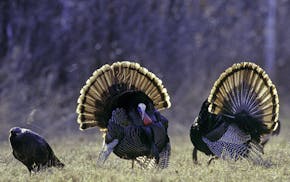Of the thousands of native plants and trees that most Americans and nearly all Minnesotans can plant in their yards, one species towers above the rest.
To do the most good for the most things, and support the most life, plant an oak tree, according to research from University of Delaware entomologist Doug Tallamy.
The reason? It's all about the bugs and, more specifically to places like Minnesota, the caterpillars.
Tallamy's research stems from the push in the past decade to replace traditional lawns and ornamental foreign plants, which can be largely sterile to North American wildlife, with more native species.
But not all native plants are equal.
"I could design a 100 percent native landscape that produces almost no caterpillars, and it would be just as sterile as a landscape loaded with plants from Asia," he said.
He and his educational group Homegrown National Park set out to find and rank the specific flora that support the most caterpillars, the building blocks of much of the country's food web. They came up with a guide for keystone plants. It's searchable county by county throughout the United States to show the top six or seven species of trees, shrubs and flowers that support the most caterpillars in each corner of the country and, in turn, the most kinds of birds and other wildlife.
His work comes as wildlife and biodiversity have plummeted across the nation, and much of the globe. North America has lost 3 billion birds from its annual population since the 1970s — about a third of all birds on the continent. The fall is primarily because of habitat destruction — the loss of the trees and plants birds need to nest and hunt. The loss has included warblers, martins, finches, meadowlarks, prairie birds, woodpeckers and herons.
Habitat loss is something that individuals, especially every home and landowner, can do something about, Tallamy said.
"We've got 135 million acres of residential landscape in the country," he said. "That's a lot of area that can be converted into functional ecosystems again. And it can be done tastefully. You don't have to give up beauty."
The best place to start is to give wildlife what they need the most.
Many small mammals and nearly every kind of bird relies on thousands upon thousands of caterpillars. For eons, terrestrial birds have hunted caterpillars more than any other insect to feed their young, Tallamy said.
"It's because they're soft, so it's easy to stuff them down the throat of your offspring," he said. "They're very high in carotenoids, which turn out to be essential to rapidly growing baby birds. They're high in protein, they're high in fat and, at least in a healthy environment, caterpillars are typically numerous."
It takes up to 9,000 caterpillars for a small clutch of chickadees to grow large enough to leave the nest. Those young birds then spend nearly another month primarily eating caterpillars as they continue to mature, Tallamy said.
"So how many caterpillars does it take to have a whole community of birds breeding successfully?" he asked. "It's a big number."
You'll find the most caterpillars munching away on the leaves of an oak tree, just about anywhere an oak tree can survive, Tallamy found.
While Tallamy's work shows that oaks are the best trees in Minnesota for fostering life in a yard or neighborhood, the key to keeping healthy and resilient wildlife is diversity, said Angela Gupta, a forester for the University of Minnesota Extension.
"If all of your neighborhood has oaks, then you're missing some opportunities and also, you're putting yourself more at risk of oak wilt coming through and taking out all of your oak trees," she said. "Oaks are definitely giants. But you can look at the list and see that wild cherries and plums and willows are also giants. So look for that diversity."
Minnesota is unique in that it marks the meeting point of three major ecosystems, supporting what is left of the prairie in the west, the boreal forest in the north and the oak savanna and eastern big woods trees in the southeastern part of the state.
Oaks are among the best for raising caterpillars in all three regions. But north of Duluth, aspen and willows become the dominant caterpillar-producing trees. Cottonwood trees become more important farther to the west, Tallamy found.
Asters, coneflowers and goldenrods are typically the best flowers to grow in much of Minnesota. Wild cherry trees and shrubs also produce enormous amounts of caterpillars throughout the state.
Caterpillars, pollinators and a host of other critters that live on any tree tend to do best when the ground immediately under it most resembles a natural forest floor, Gupta said.
Bees and butterfly populations often need fallen leaves, sticks and native shade-tolerant plants to get through the winter and complete each stage of their life cycle.
Foresters at the U have created a list of shade tolerant plants that will do well in each part of the state.

Want to help Minnesota wildlife? Plant an oak tree.
As tick season starts, another transmittable illness looms: Powassan virus
Flower flash mob: Don't miss Minnesota's spring ephemerals

Anderson: DNR wants to cut Minnesota walleye limit to 4, but some want the idea thrown back

